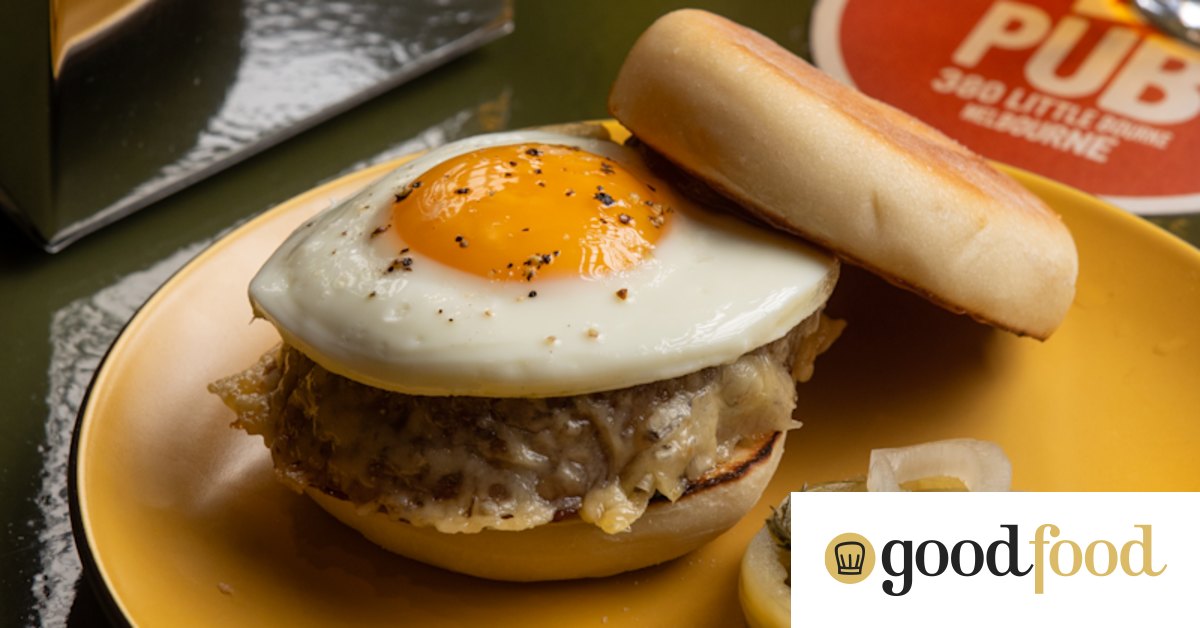Come for rendang, roti and real deal laksa; stay for the homely atmosphere and to admire Chomp Chomp’s fresh business model.
You have reached your maximum number of saved items.
Remove items from your saved list to add more.
Save this article for later
Add articles to your saved list and come back to them anytime.
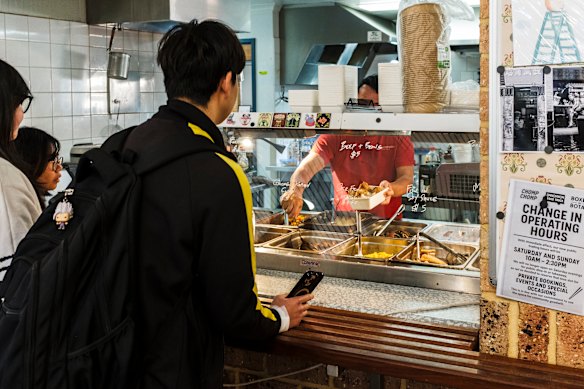
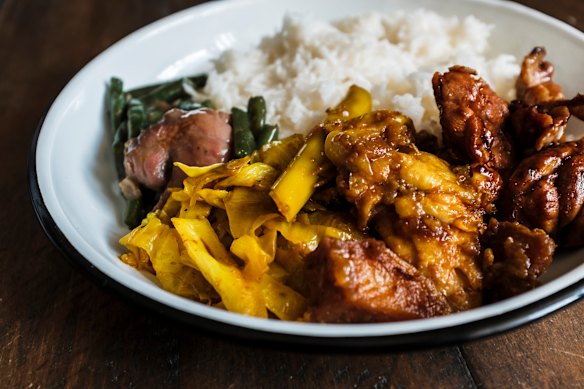
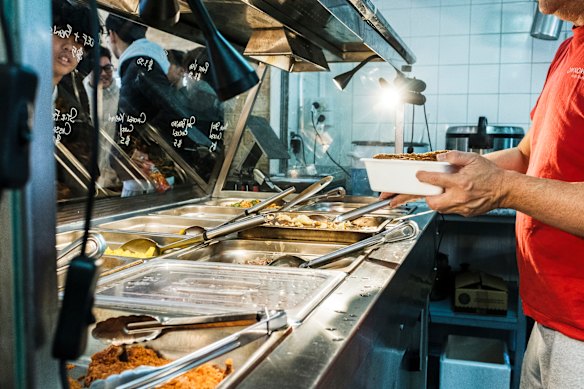
14/20
Asian$$$$
It’s 10.26am on a blue-sky, wintery Tuesday. Chomp Chomp – a bare-brick, mess hall-style canteen at Canning College in Bentley – doesn’t open for another four minutes, yet there’s already a small knot of students formed in front of its hot food display cabinet.
Peering through the glass, they point at, peruse and mentally appraise the contents of the bain maries: a dozen dishes plucked from the Singaporean comfort food multiverse shaped by Chinese, Malay, Indian and Western influences.
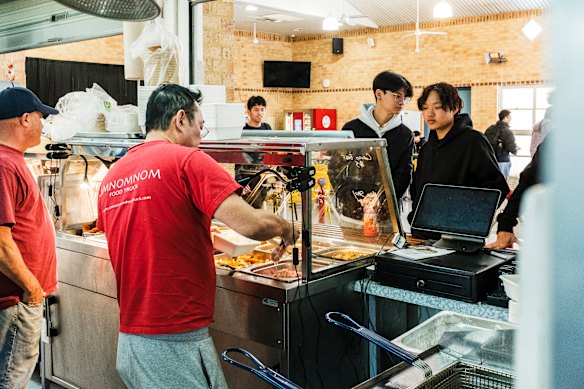
Kenneth Lim, one of Chomp Chomp’s founders, is on the other side of the cabinet and putting the final touches on the display.
The Singaporean-born, former marketer turned self-taught chef slides a tray of mashed potato into position. He gives a small jug of gravy a few final stirs. In lieu of some kind of bell ringing, the swarms of youngsters wearing hoodies and backpacks swarming into the room signals the start of recess.
The Chomp Chomp line and Lim both jolt into action. They point at things. He packs them into cardboard takeaway containers feathered with rice, just as the legions of aunties and uncles of Singapore’s economy rice stalls do, day in and day out.
The golden fried pork cutlet, unsurprisingly, is a popular choice. Like that potato and mash, this Singaporean “western” dish was invented during Singapore’s colonial era by Hainanese cooks who discovered that coating pork in a layer of crushed cream crackers yielded max crunch.
The gold of the ayam Kapitan or “captain’s chicken”, however, is derived from turmeric rather than a deep fryer. Like the pork, this rich, dry curry sharp with lemongrass is also a product of cultural exchange: in this instance, the intermarriage between Chinese seafarers and local Malays that laid the foundations for Peranakan cuisine.
But more often than not, the dishes in the buffet draw on Lim’s Chinese heritage. Dominoes of topside beef and stubby pencils of green bean are glossy with oyster sauce supercharged with a hefty grind of black pepper. Chunky lobes of chicken thigh braised in soya sauce feel like something a Singaporean teen might request for a homecoming meal. Garden-variety school canteen dishes these ain’t. Nor is Chomp Chomp a garden-variety school canteen.
According to Lim, this is WA’s only school cafeteria that’s open to the public. Sort of.
During the week, this is a strictly students and staff zone, but on weekends, the red carpet gets unfurled for all.
It was this possibility of weekend trade that, in addition to a captive audience during the week, convinced Lim and his business partner Glenn Saberton to permanently park their food truck Om Nom Nom at Canning College, resuscitate the cafeteria that had lain dormant for four years, and open a permanent bricks-and-mortar address at the start of 2024.
Like Lim, Saberton also identifies as a home cook. In his case, it was watching MasterChef during his downtime while flying helicopters in the mines that piqued his interest. While Saberton is on deck during the week, many of his creations populate the more brunch-minded weekend menu.
Creations such as a saucy curry of tender barramundi ringing with the deep ripeness of eggplant, say, or an arresting laksa bulky with thick, shoelace-like rice noodles in a dense, unkempt broth rampant with the thrust of spice and reassuring richness of coconut milk. This soup noodle is one of the planet’s few dishes in which the descriptor “sludgy” might be considered a compliment.
Saturdays and Sundays also see Lim and Saberton joined by Indran Raja: an international student who came to Perth to study engineering, but while here, learned to cook the Indian-Muslim mamak food that he missed from home.
His contributions include a murky sup kambing (bone-in mutton soup) served with toasted chunks of buttery French bread, and a pleasing mamak mee goreng – charry, but not too sweet – that’s furiously stir-fried and tossed outdoors on a fierce, gas-powered wok burner.
Having tried both the weekend and weekday menus (taking photos and fact-checking is hungry work, you know) I’m pleased to report that the quality of the cooking is universally good, although two caveat emptors are worth keeping in mind.
First, Chomp Chomp’s trading conditions requires everything to be served in takeaway containers. For any other eaters trying to be more conscientious consumers, consider bringing your own Tupperware containers and cutlery when dining here. Or anywhere, really.
Secondly: the home-style nature of the kitchen means that eaters may have to wait a while for some dishes on weekends. If everyone in your party is happy to share and the mood is long lunch, the pace of service shouldn’t be an issue. If it’s every diner for themselves though, some eaters may feel like they’ve been forgotten as they sit there, empty-plated, watching buddies rip into hand-pulled roti prata and beef rendang.
I write the above, however, not as deterrents, but as pieces of advice, one enthusiastic eater to another. Chomp Chomp is an earnest, deeply likeable eatery that doesn’t just offer homely, real-deal Singaporean cooking, but also a homely, real-deal Singaporean atmosphere. The counter is dressed with vintage cookbooks and colourful prints. The students talk to Lim and Saberton with a familiarity that suggests that the young ones consider these two “uncles” as more than just people that cook their food.
Best of all, Chomp Chomp is powered by a clever business model that I haven’t seen out west before, yet it sits comfortably along WA’s underground barbecue parlours, bowls club takeovers and skate park curry canteens.
At a time when many hospitality operators are struggling, this is a fine example of a resourceful, left-field approach that operators – and even schools – might want to consider. And, just as it’s always been in food circles, fortune favours those at the front of the line.
The low-down
Atmosphere: Surprise! A college canteen serving home-cooked Singaporean comfort food to students and clued-up locals.
Go-to dishes: sup kambing, laksa.
Drinks: Singaporean-style teh tarik (pulled tea) and Asian soft drinks.
Cost: about $40 for two people.
Good Food reviews are booked anonymously and paid independently. A restaurant can’t pay for a review or inclusion in the Good Food Guide.
Restaurant reviews, news and the hottest openings served to your inbox.
You have reached your maximum number of saved items.
Remove items from your saved list to add more.




